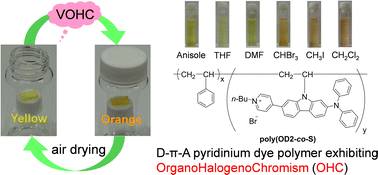Organohalogenochromism (OHC) of D–π–A pyridinium dye polymer films and the colorimetric detection of volatile organic halogen compounds†
Abstract
Volatile organohalogen compounds (VOHCs) are commonly used in manufacturing; however, most of them are extremely toxic to human health, biological systems and the environment even when exposed to small quantities. Meanwhile, organohalogenochromism (OHC) is a photophysical phenomenon that induces a significant hypsochromic or bathochromic shift of photoabsorption bands of organic dyes in halogenated solvents compared with those in non-halogenated solvents. Thus, in this study, to ensure the expression of OHC and to develop optical polymeric materials based on OHC for the visualization and detection of VOHCs, we designed and synthesized a D–π–A type pyridinium dye monomer OD2-V possessing intramolecular charge transfer (ICT) characteristics and prepared a copolymer poly(OD2-co-S) composed of OD2-V and styrene. It was found that poly(OD2-co-S) and OD2-V exhibit bathochromic shift-type OHC (b-OHC) in the solution state. However, the D–π–A type pyridine dye NI2-V and its copolymer poly(NI2-co-S) composed of NI2-V and styrene did not exhibit such OHC. Furthermore, drop-casted poly(OD2-co-S) film exhibits the bathochromic shift of the ICT-based photoabsorption band in the halogenated solvent–vapor atmosphere, that is, a visual change in color from yellow to orange upon exposure to VOHCs, including dichloromethane (CH2Cl2) and chloroform (CHCl3). Indeed, the poly(OD2-co-S) film exhibits a good reversible switching of the ICT-based photoabsorption band in the air and VOHC-vapor atmosphere process. The optical sensing properties of poly(OD2-co-S) film to VOHCs, 1H NMR spectral measurements and semi-empirical molecular calculations for OD2-V demonstrate that the enhanced ICT characteristics of OD2 chromophore induced by the intermolecular interaction between the dye and the organohalogen molecules are responsible for the b-OHC of D–π–A type pyridinium dyes. Consequently, we propose that polymeric organohalogenochromic dyes are one of the most promising and convenient functional materials for the colorimetric detection of VOHCs.



 Please wait while we load your content...
Please wait while we load your content...